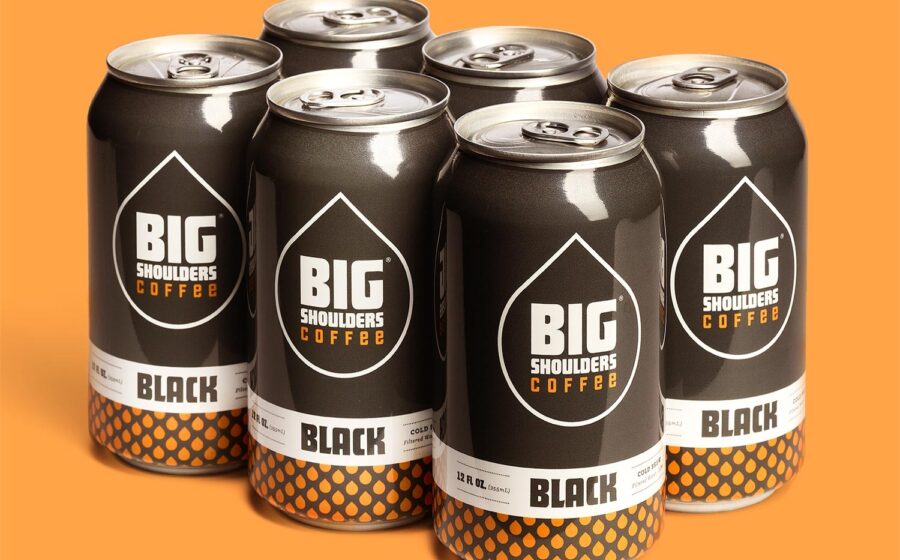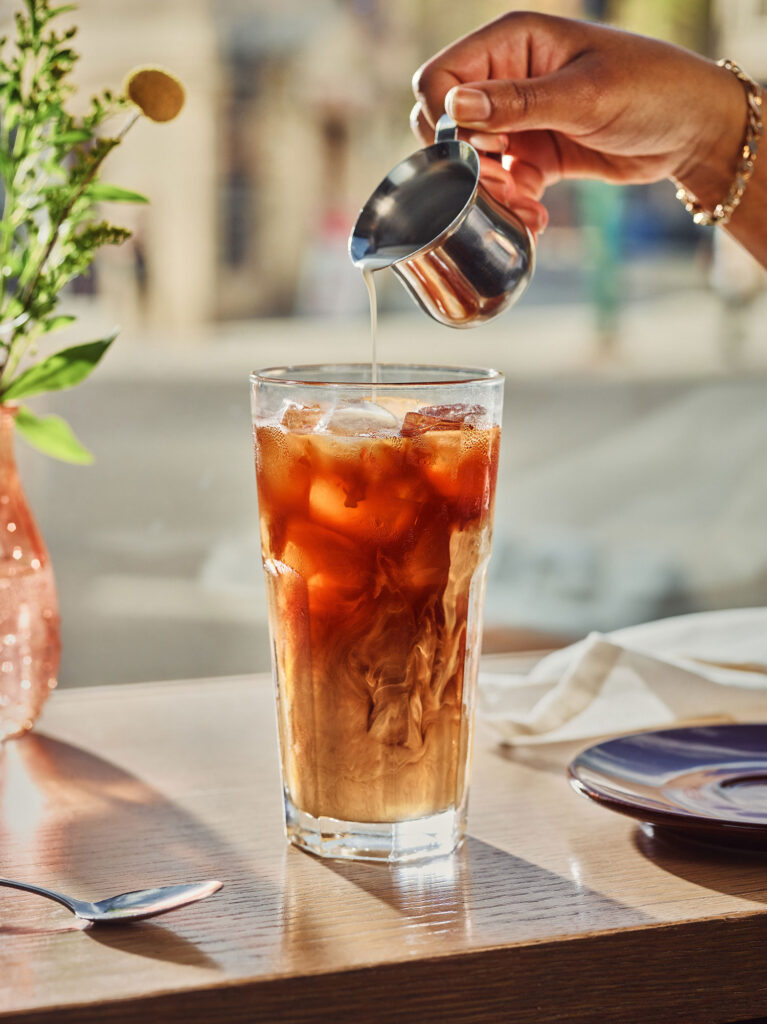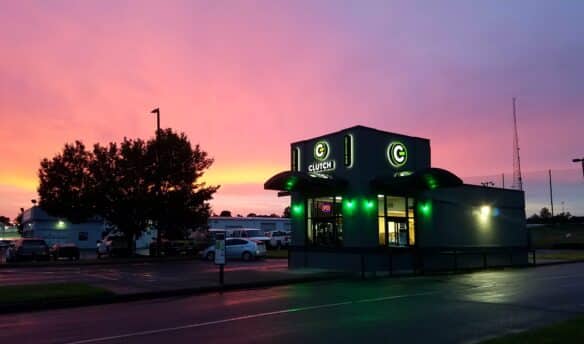More customers are drinking cold coffee beverages than ever before. In 2021, Americans showed an increased preference for cold coffee drinks, with a staggering 60% rise in consumption over seven years. During the same year, Starbucks shared that 74% of all their coffee drink sales were cold year-round.
It’s clear that the popularity of cold coffee is no longer limited to the summer months, and café owners should take note. How can coffee shops create a menu that meets the growing demand for cold drinks all year round?
A New Era of Cold Coffee
A decade ago, iced drinks comprised only around 30% of sales at Big Shoulders Coffee, an award-winning roastery and coffee chain in Chicago, Ill. But founder Tim Coonan says cold drinks have gained momentum in recent years—and he believes they’re here to stay. “I can confidently say it’s flip-flopped and iced beverages represent about 60% of our sales.”
Chicago may be known for its frigid winters, but that hasn’t stopped Big Shoulders customers from embracing cold coffee drinks year-round. Although cold brew sales dip during the winter months, it’s offset by the enduring popularity of their espresso-driven iced drinks.
Big Shoulders has emphasized the development of specialty iced lattes that draw upon another industry: the alcoholic beverage industry. Coonan believes today’s cafés need to offer a value-add for iced coffee that goes beyond your basic cold brew—and he attributes their success with seasonal menus to the creativity of their drinks specialist, Alicia Scott.
A former mixologist, Scott brings her methodology into crafting recipes for the shop’s seasonal menu and creating flavor profiles that combine different cocktail-making techniques. “What we’ve tried to do is follow the trend with cocktails and the thoughtfulness that bartenders and mixologists are putting into those finished beverages,” Coonan says.
Other cafes are also tapping into cocktail culture to add a creative twist to their menu. Andytown Coffee Roasters in San Francisco found success with their Snowy Plover: a brown sugar syrup and espresso soda that has become a signature menu item. Similarly, the Michigan-based Madcap Coffee introduced the Espresso Moscow Mule—a combination of espresso and house-made ginger-lime syrup, which is stirred together, strained over ice, and topped with sparkling water.
By staying plugged into the latest cocktail trends, Scott has introduced non-alcoholic coffee drinks featuring savory flavors and garnishes like sage and rosemary. For example, Big Shoulders recently released a seasonal holiday beverage made with white chocolate and rosemary garnished with white chocolate peppermint bark. Another well-known menu item was The Painted Lady, a seasonal drink made with simple syrup, tart ginger lemonade, Colombian iced coffee, and mint, shaken and served over ice.
“That worked well,” says Coonan. “Those are the kinds of creative things that we think about with cold beverages and driving a cold menu.”
Crafting A Memorable Drink Experience
Before he launched Big Shoulders, Coonan started his career as a culinary chef at some of the top restaurants in New York, Chicago, France, and Italy. He taps into his prior experience by putting a culinary twist on coffee. “I’m a real believer that there is a theater component to hospitality,” he shares. This is evident in menu items like the marshmallow latte, which is so beloved by customers that it’s become a permanent fixture on their menu.
Served either hot or cold, the latte is made by placing a marshmallow on a skewer and using a blowtorch to toast it at the counter—similar to the process used in a kitchen to create a crème brulée or to toast the top of a custard.
Coonan feels these drinks taste incredible and create memorable customer experiences. The marshmallow latte is not only one of their bestselling drinks but also their most photographed menu item. “People love to see that because it’s made right in front of them. Of course, there’s a lot of enjoyment in having a gooey, warm marshmallow to bite into while sipping coffee—we see a lot of people dunk it into their coffee, too,” he says.
Developing a menu of cold coffee drinks with unique flavor combinations can be a winning strategy for café owners looking to stand out in a competitive market. By creating complex and visually memorable iced coffee drinks, coffee shops can potentially command higher prices and increase their profit margins. Plus, it’s more likely to generate buzz from customers sharing their experiences online.
Tried And Tested Combinations
While Big Shoulders experiments with seasonal drinks, the café’s core menu intentionally focuses on drinks that work well both hot and cold—and considers which type of coffees, roast profiles, and milk complements a beverage. For instance, the cafe offered a seasonal beverage, the Cafe Bombon, which featured a shot of espresso poured over sweetened condensed milk, mixed, and combined with ice.
This ethos extends to their coffee roasting process: “There are a lot of coffees we roast that are for a broad variety of people, a broad variety of palettes—light, medium, and dark roast,” Coonan says. “We also have to think about it from the perspective of people that drink their coffee with sugar and alternative sweeteners.”
Testing cold drink recipes with various milk and sweeteners is the key to ensuring they work well when it comes to the visual appeal and flavor profile, says Coonan. Nut and grain milks behave differently than dairy and may curdle or separate when too cold—and they can impact the overall flavor profile.
For example, nut milks such as almond may compete with other flavors in a recipe, like the floral undertones in a lavender latte. “It lends a bit of bitterness but also works well with some drinks.” According to Coonan, almond milk’s bitterness pairs nicely with the flavors in Big Shoulders’ popular cardamom latte, like orange, cinnamon, and star anise.
Although customers can decide which milk they’d like with their drink, Big Shoulders tries to encourage patrons to try the suggested milk pairing. “We try to educate the customer as best we can about what we feel the best accompaniment is with those drinks, without being overly fussy or stuffy about those sorts of things,” he says. “And generally, people are responsive to that.”
The Future of Cold Coffee
Gen Z is a demographic cohort beginning to make its presence felt in the coffee industry, especially with cold drinks. Coonan also attributes the growing cold coffee trend in part to the ever increasing availability of ready-to-drink beverages in places like gas stations, groceries, and restaurants.
“One of the things that happened out of the pandemic was just people trying to figure out how to introduce more SKUs and more sales opportunities to their customers,” he says. In response, Big Shoulders began bottling many of their own drinks, which could be purchased in-house or taken home. With the convenience factor being a major driver of the grab-and-go trend in food service, Coonan feels customers are likely to continue seeking out quick and accessible options for their daily coffee as well.
How should coffee shops start experimenting with their cold coffee menu? According to Coonan, it begins with listening to your customers. You might take inspiration from popular hot beverages and experiment with transforming them into cold drinks—but don’t lose sight of the things that are tried and true in the coffee world. “Chocolate has such an affinity with coffee.”
That’s where he says you can start playing with flavors and certain spices—like using citrusy orange or tangerine to counterbalance the sweetness of chocolate and elevate its bitterness with certain spices. “You’ve got cinnamon, mint, nutmeg, cayenne, black pepper, and Sichuan peppercorns,” he says. “These are all things that can play off chocolate really well.”
Coonan encourages owners to go back to the basics during recipe development. “Things that might seem basic can actually be quite elevated,” he says. For example, pure vanilla paste extracted from pods can enhance a drink’s flavor profile. “Use quality ingredients and experiment with making your own, even if it’s just making a gallon of pistachio milk or a small-batch special run. Those are the things café owners can be looking at.”
Cafés can take advantage of the growing cold-coffee trend to diversify their menu and draw in new customers. With a little experimentation and creativity, it’s possible to offer a diverse and exciting range of iced coffee options that keep customers coming in all year round.
Photos courtesy of Big Shoulders Coffee

















